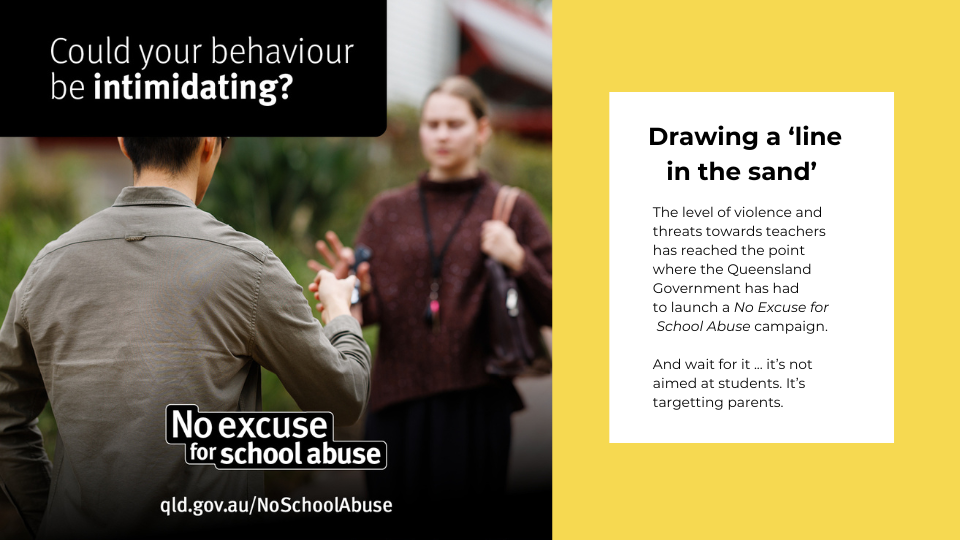The alarming rise of violence in Australian schools needs urgent solutions.
As incidents escalate, both students and teachers are caught in an increasingly volatile environment.
“If the average person knew what teachers put up with every single day in terms of occupational violence,” says former Queensland Education Minister Di Farmer, “they would fall off their chair.
“Some of the stories that you hear are shocking.”
In Queensland, the “No Excuse for School Abuse” campaign aims to address this issue by targeting parents and caregivers, while organisations such as the Pat Cronin Foundation are expanding educational programs to promote violence prevention.
But how did we reach this point, and what can be done to reverse the trend?
In this article, we’ll explore:
- Why violence and threats in schools have been increasing over the past 13 years, according to leading Australian education experts.
- The extent of school violence, not just in Queensland but across Australia.
- What needs to change to create safer school environments.
- How the Pat Cronin Foundation is contributing to violence-prevention education in Queensland.
The Rise of Violence in Australian Schools
The increasing aggression in schools isn’t a new phenomenon, but it has been intensifying.
Dr Paul Kidson, a former high school principal with over 11 years of experience, has witnessed firsthand the growing threats and violence in educational settings.
In an interview with the Foundation, he spoke about his experiences reflecting the alarming results of a national survey conducted by the Australian Catholic University.
The annual Australian Principal Occupational Health, Safety and Wellbeing Survey, which he helps author, paints a grim picture of the abuse faced by school leaders.
According to the data, 48% of the 2,300 school principals surveyed reported being victims or witnesses of physical violence, with 54% having faced threats.
Physical violence against school leaders up 76 per cent
A shocking 96.3% of the violence was perpetrated by students, but threats from parents and caregivers remain high at 65.6%. Since 2011, physical violence against school leaders has increased by a staggering 76.5%.
This national crisis has reached a tipping point, with over half of the surveyed school principals indicating their intention to quit or retire early.
Experienced leaders, many with more than 15 years of service, are leading this exodus, disillusioned by the deteriorating respect and support they encounter.
Dr Kidson’s personal account is chilling: “I’ve had parents poke me in the chest, stand over me, and threaten me to my face in front of senior staff.”
The behaviour of parents seems to trickle down to their children, with teachers observing a notable decline in respect in the classroom, even among younger, primary school-aged students.
He notes: “We’re talking about primary-age children who look to their caregivers as examples. They’ll say: ‘I’ve seen how you deal with this thing.’”

Former Queensland Education Minister Di Farmer
The “No Excuse for School Abuse” Campaign in Queensland
In response to the growing crisis, former Queensland Education Minister Di Farmer spearheaded the “No Excuse for School Abuse” campaign.
This initiative states unequivocally that aggressive behaviour—whether in person or online—will no longer be tolerated.
“Teachers have been telling us that school environments are becoming more and more complex as they deal with occupational violence, aggression, student behaviour, and administrative workload,” Ms Farmer says.
The campaign aims to address these complexities by promoting respect and zero tolerance for aggression.
This campaign is a first step. Other initiatives include psychological first aid training for teachers, collaboration with universities to train pre-service educators in classroom behaviour management, and providing ongoing wellbeing support for staff affected by violence.

The Pat Cronin Foundation’s Role in Violence Prevention
As the Queensland government promotes its campaign, the Pat Cronin Foundation is expanding its presence in the state, focusing on violence-prevention education at student level.
Since February 2024, the Foundation has reached over 6000 students across southeast Queensland, from Brisbane’s southern suburbs to the Sunshine Coast.
Foundation director Matt Cronin believes that programs like this are more vital than ever.
“From the feedback we’re getting, our programs are needed more than ever in Queensland.
“We’re committed to changing ingrained, cultural attitudes to violence and aggression wherever we go.”
While the government’s campaign is targeted primarily at parents and carers, the Foundation emphasises the importance of reaching students early.
Mr Cronin says: “Changing cultural attitudes to violence needs to start at a young age. By sparking conversations around the dinner table, we can make a real difference in how families approach conflict and aggression.”

Dr Paul Kidson, of the Australian Catholic University
Why Aggression in Schools Is Increasing
Dr Kidson highlights several societal shifts that he believes are contributing to the rise of aggression in schools over the past decade:
- A growing lack of resilience: Students are increasingly unable to cope with challenges, leading to frustration and outbursts in the classroom.
- The rise of social media: The effects of social media on adolescent well-being cannot be overstated. Platforms that encourage comparison and instant gratification exacerbate anxiety and stress, which often spills over into the school environment. The phenomenon is highlighted in Jonathon Haidt’s book, The Anxious Generation.
- Hyper-individualism: A culture of “me first” is leading to a breakdown in community values, as families and students prioritise individual needs over the collective good.
- Litigiousness in families: Parents are increasingly willing to take legal action against schools over perceived slights, further complicating teachers’ ability to enforce discipline and provide constructive feedback.
Dr Kidson recalls a story that he reported to a Senate inquiry into classroom disruption about a well-intentioned teacher who told a student they would need to put in more work to achieve their goals.
“The student goes home to a parent and complains, and the parent complains to the principal.
“The principal calls the teacher in and says to apologise to the family for causing undue stress.
Says Dr Kidson: “I think we actually do want teachers to be able to say to students: ‘You need to put a little bit more effort in’.”
What needs to change
The rising violence in Australian schools is a complex issue with no easy solution. However, addressing the root causes—such as societal shifts, the influence of social media, and the breakdown of respect—can help reverse the trend.
Programs like the Pat Cronin Foundation’s violence-prevention education and campaigns like “No Excuse for School Abuse” are critical first steps.
Supporting teachers and school leaders, providing them with the tools to manage increasingly challenging environments, and fostering community-wide conversations around respect and resilience will be essential in creating safer schools for everyone.
The time to act is now, before more educators are lost to early retirement, and more students suffer the consequences of unchecked aggression in the classroom.

